Research Skills: Internet as Health Info Source for Students
VerifiedAdded on 2023/01/17
|9
|1203
|32
Report
AI Summary
This report investigates the use of the internet as a source of health information among higher education students. It aims to analyze the importance, usage, and benefits of the internet in this context. The background highlights the prevalence of internet use for health information, with students often relying on search engines and websites. The literature search reveals increasing internet usage among students, particularly for health-related information, with studies examining gender, internet experience, and online health programs. The methodology employed is qualitative research with secondary data analysis, using an exploratory research design, secondary data collection, thematic data analysis, and an inductive research approach with an interpretivism philosophy. The report references several studies that support the findings, focusing on how students use the internet to enhance their health knowledge and make informed decisions.

RESEARCH SKILLS
Paraphrase This Document
Need a fresh take? Get an instant paraphrase of this document with our AI Paraphraser
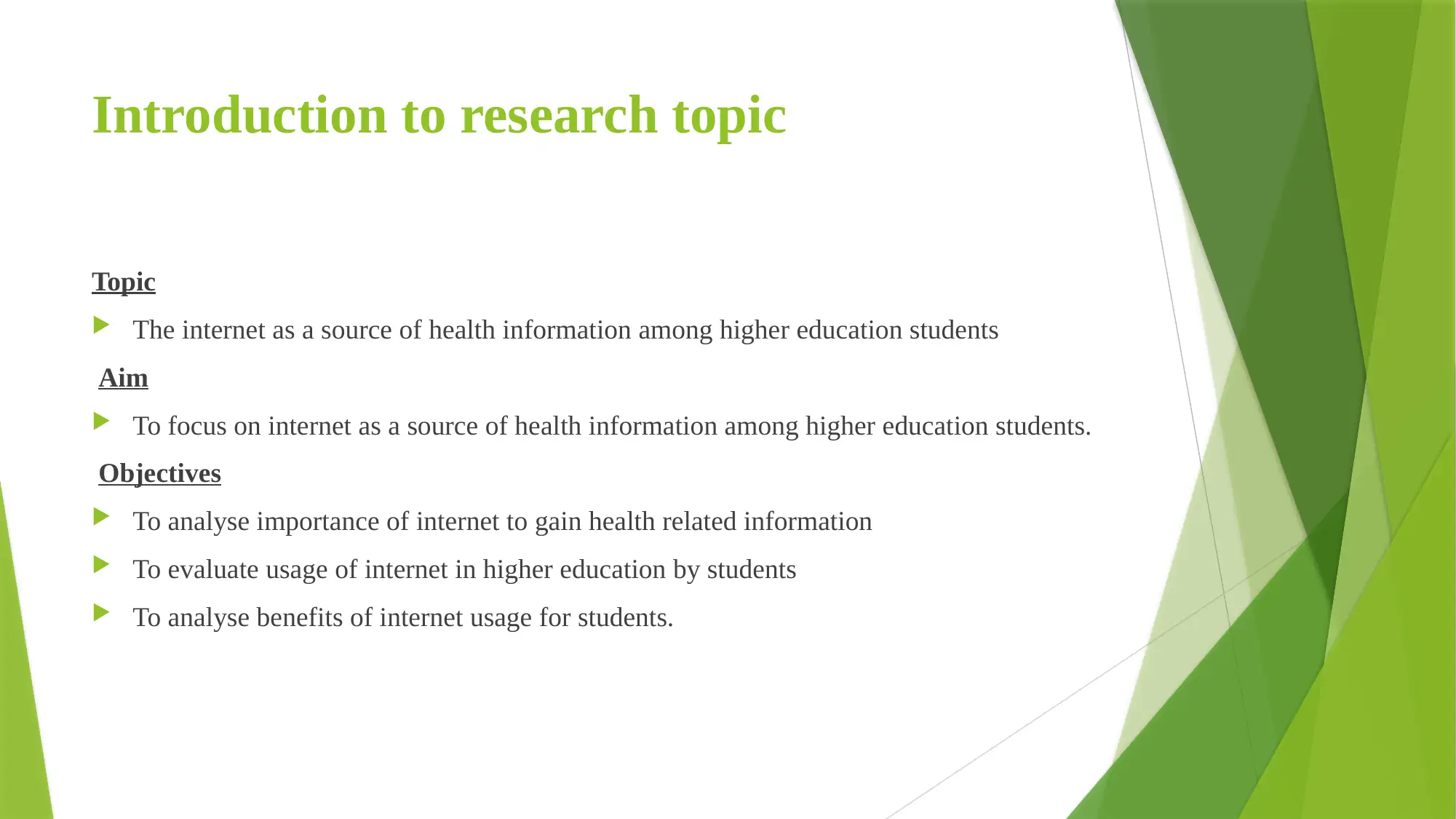
Introduction to research topic
Topic
The internet as a source of health information among higher education students
Aim
To focus on internet as a source of health information among higher education students.
Objectives
To analyse importance of internet to gain health related information
To evaluate usage of internet in higher education by students
To analyse benefits of internet usage for students.
Topic
The internet as a source of health information among higher education students
Aim
To focus on internet as a source of health information among higher education students.
Objectives
To analyse importance of internet to gain health related information
To evaluate usage of internet in higher education by students
To analyse benefits of internet usage for students.
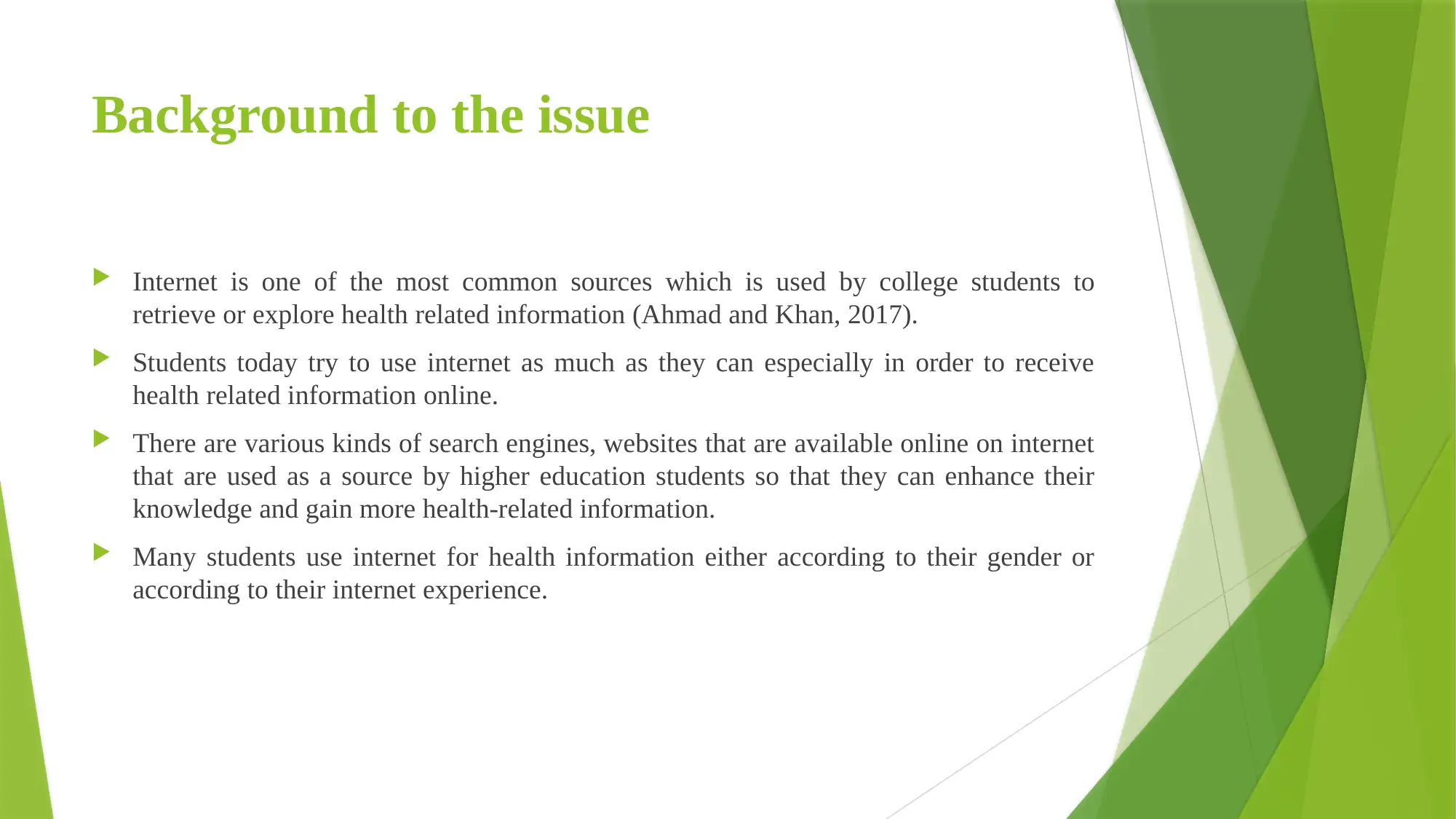
Background to the issue
Internet is one of the most common sources which is used by college students to
retrieve or explore health related information (Ahmad and Khan, 2017).
Students today try to use internet as much as they can especially in order to receive
health related information online.
There are various kinds of search engines, websites that are available online on internet
that are used as a source by higher education students so that they can enhance their
knowledge and gain more health-related information.
Many students use internet for health information either according to their gender or
according to their internet experience.
Internet is one of the most common sources which is used by college students to
retrieve or explore health related information (Ahmad and Khan, 2017).
Students today try to use internet as much as they can especially in order to receive
health related information online.
There are various kinds of search engines, websites that are available online on internet
that are used as a source by higher education students so that they can enhance their
knowledge and gain more health-related information.
Many students use internet for health information either according to their gender or
according to their internet experience.
⊘ This is a preview!⊘
Do you want full access?
Subscribe today to unlock all pages.

Trusted by 1+ million students worldwide

Literature search findings
According to the view of Humphrey-Ackumey, Adams and Ahenkorah-Marfo, (2019)
Nowadays usage of internet is increasing excessively.
It is being used by ungraduated, graduate, post-graduate students mostly as compared to other.
In other words, most of the higher education students use internet for retrieval of information.
They use internet to enhancing their knowledge about health seeking behaviour, attitude and
other information related to health.
Many students browse information available on websites on internet, some join online health
related programs or courses.
There are smaller number of students who do not use internet for retrieval of information as
compared to majority of students. Internet provides range of health information for consumers
and for students perusing health education.
Other than this it also has potential of improving an individual’s health. Internet is also used to
gain health related information in order to enhance one’s own decision making.
According to the view of Humphrey-Ackumey, Adams and Ahenkorah-Marfo, (2019)
Nowadays usage of internet is increasing excessively.
It is being used by ungraduated, graduate, post-graduate students mostly as compared to other.
In other words, most of the higher education students use internet for retrieval of information.
They use internet to enhancing their knowledge about health seeking behaviour, attitude and
other information related to health.
Many students browse information available on websites on internet, some join online health
related programs or courses.
There are smaller number of students who do not use internet for retrieval of information as
compared to majority of students. Internet provides range of health information for consumers
and for students perusing health education.
Other than this it also has potential of improving an individual’s health. Internet is also used to
gain health related information in order to enhance one’s own decision making.
Paraphrase This Document
Need a fresh take? Get an instant paraphrase of this document with our AI Paraphraser
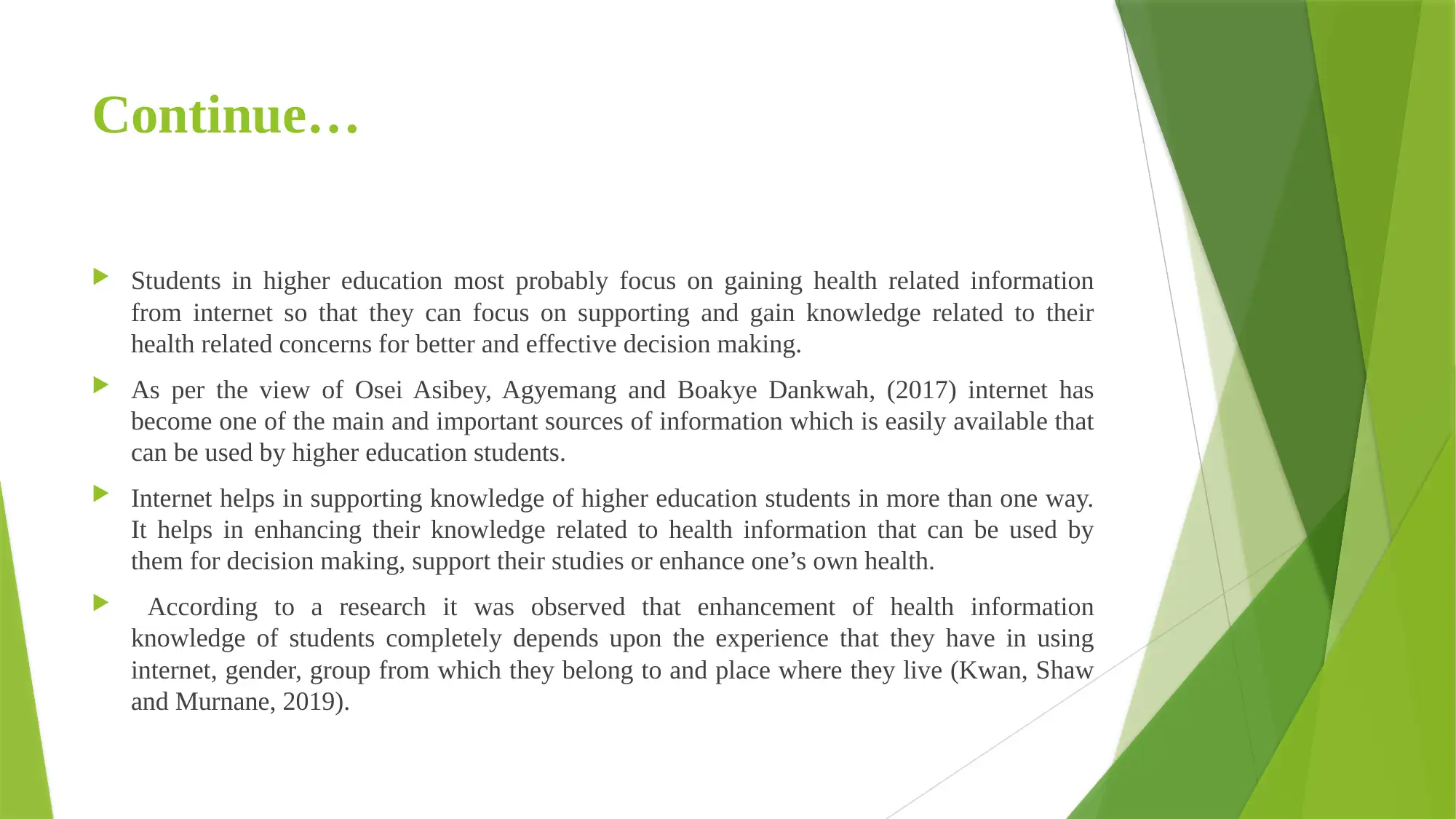
Continue…
Students in higher education most probably focus on gaining health related information
from internet so that they can focus on supporting and gain knowledge related to their
health related concerns for better and effective decision making.
As per the view of Osei Asibey, Agyemang and Boakye Dankwah, (2017) internet has
become one of the main and important sources of information which is easily available that
can be used by higher education students.
Internet helps in supporting knowledge of higher education students in more than one way.
It helps in enhancing their knowledge related to health information that can be used by
them for decision making, support their studies or enhance one’s own health.
According to a research it was observed that enhancement of health information
knowledge of students completely depends upon the experience that they have in using
internet, gender, group from which they belong to and place where they live (Kwan, Shaw
and Murnane, 2019).
Students in higher education most probably focus on gaining health related information
from internet so that they can focus on supporting and gain knowledge related to their
health related concerns for better and effective decision making.
As per the view of Osei Asibey, Agyemang and Boakye Dankwah, (2017) internet has
become one of the main and important sources of information which is easily available that
can be used by higher education students.
Internet helps in supporting knowledge of higher education students in more than one way.
It helps in enhancing their knowledge related to health information that can be used by
them for decision making, support their studies or enhance one’s own health.
According to a research it was observed that enhancement of health information
knowledge of students completely depends upon the experience that they have in using
internet, gender, group from which they belong to and place where they live (Kwan, Shaw
and Murnane, 2019).
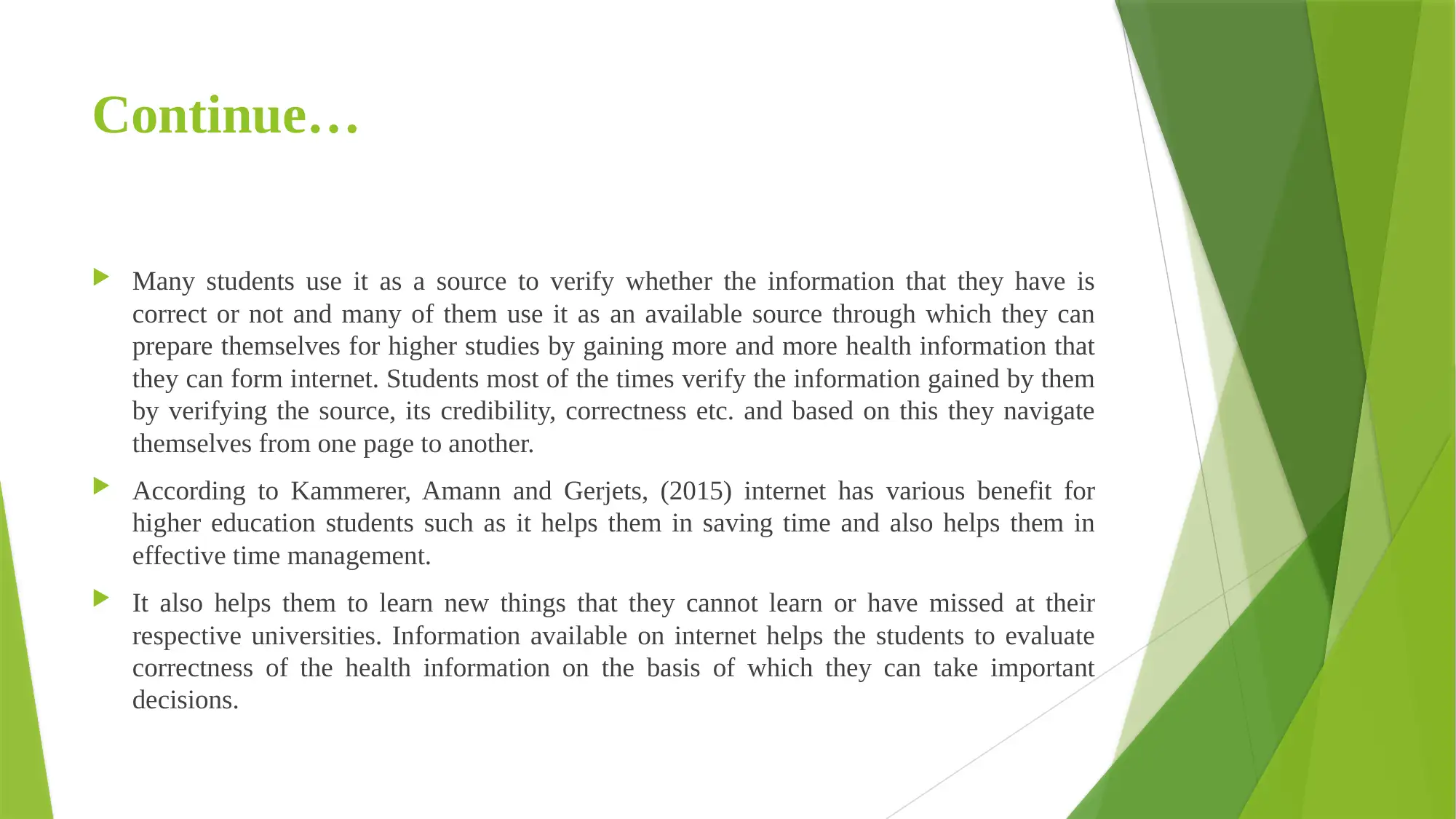
Continue…
Many students use it as a source to verify whether the information that they have is
correct or not and many of them use it as an available source through which they can
prepare themselves for higher studies by gaining more and more health information that
they can form internet. Students most of the times verify the information gained by them
by verifying the source, its credibility, correctness etc. and based on this they navigate
themselves from one page to another.
According to Kammerer, Amann and Gerjets, (2015) internet has various benefit for
higher education students such as it helps them in saving time and also helps them in
effective time management.
It also helps them to learn new things that they cannot learn or have missed at their
respective universities. Information available on internet helps the students to evaluate
correctness of the health information on the basis of which they can take important
decisions.
Many students use it as a source to verify whether the information that they have is
correct or not and many of them use it as an available source through which they can
prepare themselves for higher studies by gaining more and more health information that
they can form internet. Students most of the times verify the information gained by them
by verifying the source, its credibility, correctness etc. and based on this they navigate
themselves from one page to another.
According to Kammerer, Amann and Gerjets, (2015) internet has various benefit for
higher education students such as it helps them in saving time and also helps them in
effective time management.
It also helps them to learn new things that they cannot learn or have missed at their
respective universities. Information available on internet helps the students to evaluate
correctness of the health information on the basis of which they can take important
decisions.
⊘ This is a preview!⊘
Do you want full access?
Subscribe today to unlock all pages.

Trusted by 1+ million students worldwide
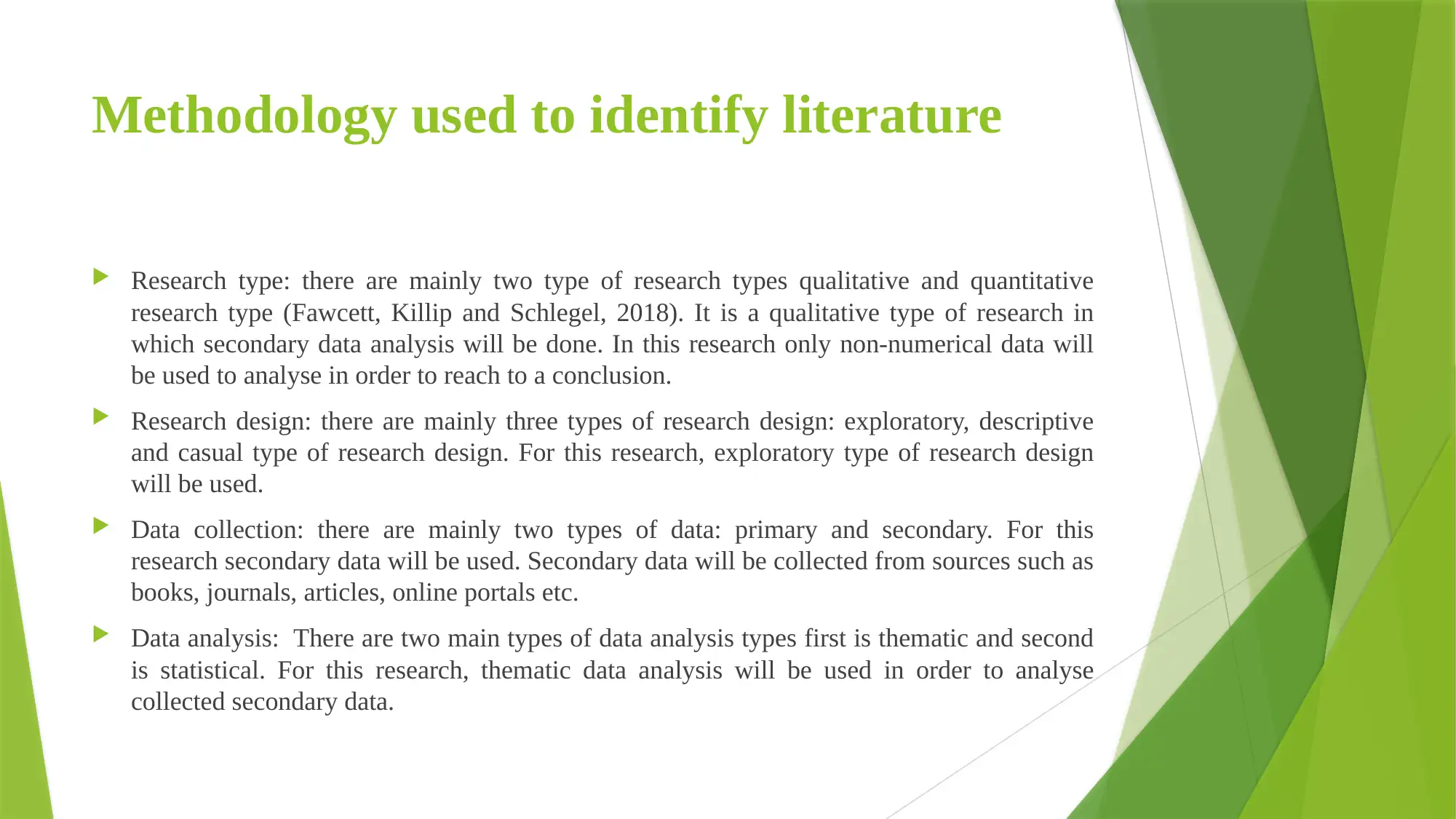
Methodology used to identify literature
Research type: there are mainly two type of research types qualitative and quantitative
research type (Fawcett, Killip and Schlegel, 2018). It is a qualitative type of research in
which secondary data analysis will be done. In this research only non-numerical data will
be used to analyse in order to reach to a conclusion.
Research design: there are mainly three types of research design: exploratory, descriptive
and casual type of research design. For this research, exploratory type of research design
will be used.
Data collection: there are mainly two types of data: primary and secondary. For this
research secondary data will be used. Secondary data will be collected from sources such as
books, journals, articles, online portals etc.
Data analysis: There are two main types of data analysis types first is thematic and second
is statistical. For this research, thematic data analysis will be used in order to analyse
collected secondary data.
Research type: there are mainly two type of research types qualitative and quantitative
research type (Fawcett, Killip and Schlegel, 2018). It is a qualitative type of research in
which secondary data analysis will be done. In this research only non-numerical data will
be used to analyse in order to reach to a conclusion.
Research design: there are mainly three types of research design: exploratory, descriptive
and casual type of research design. For this research, exploratory type of research design
will be used.
Data collection: there are mainly two types of data: primary and secondary. For this
research secondary data will be used. Secondary data will be collected from sources such as
books, journals, articles, online portals etc.
Data analysis: There are two main types of data analysis types first is thematic and second
is statistical. For this research, thematic data analysis will be used in order to analyse
collected secondary data.
Paraphrase This Document
Need a fresh take? Get an instant paraphrase of this document with our AI Paraphraser
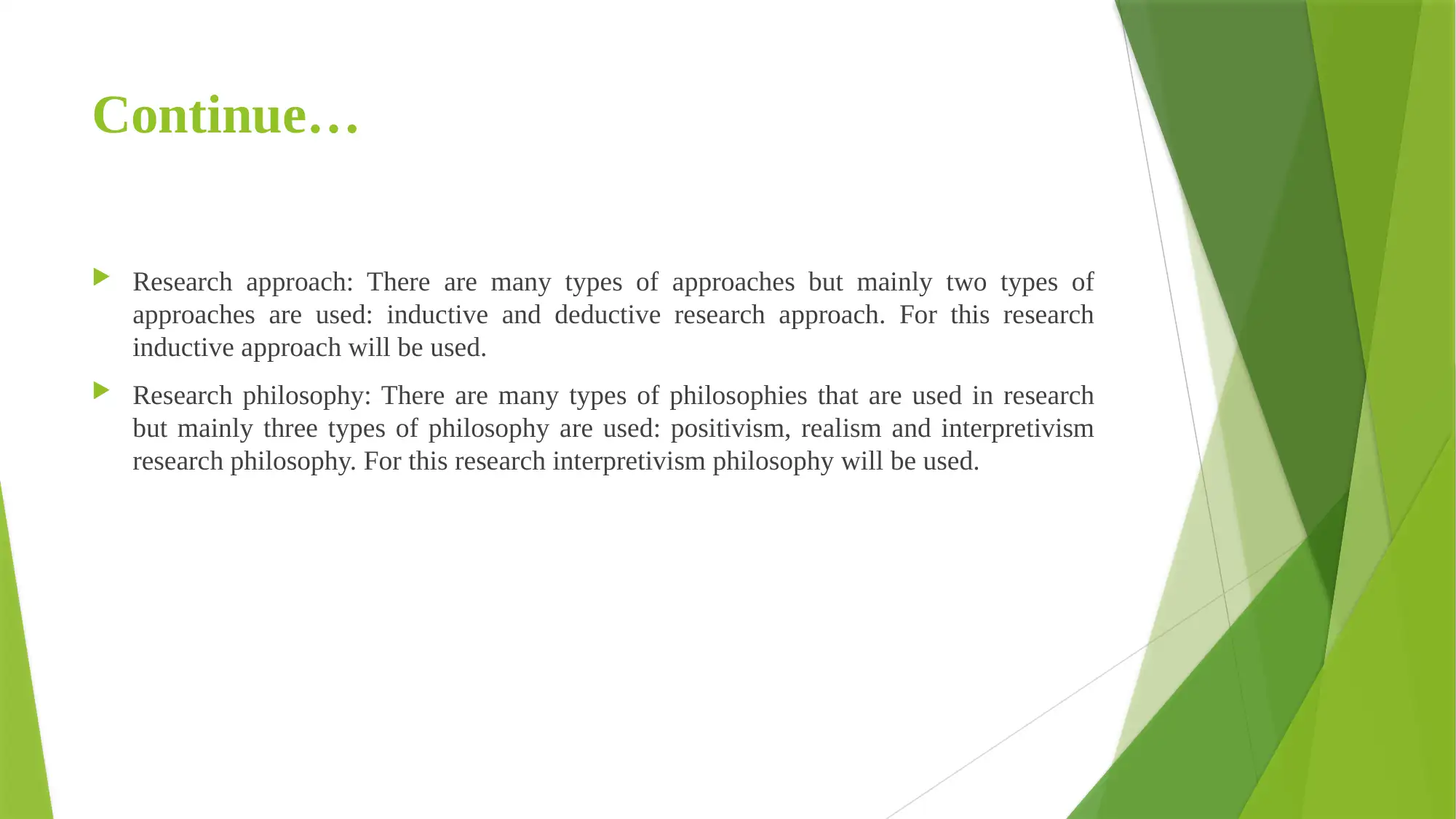
Continue…
Research approach: There are many types of approaches but mainly two types of
approaches are used: inductive and deductive research approach. For this research
inductive approach will be used.
Research philosophy: There are many types of philosophies that are used in research
but mainly three types of philosophy are used: positivism, realism and interpretivism
research philosophy. For this research interpretivism philosophy will be used.
Research approach: There are many types of approaches but mainly two types of
approaches are used: inductive and deductive research approach. For this research
inductive approach will be used.
Research philosophy: There are many types of philosophies that are used in research
but mainly three types of philosophy are used: positivism, realism and interpretivism
research philosophy. For this research interpretivism philosophy will be used.
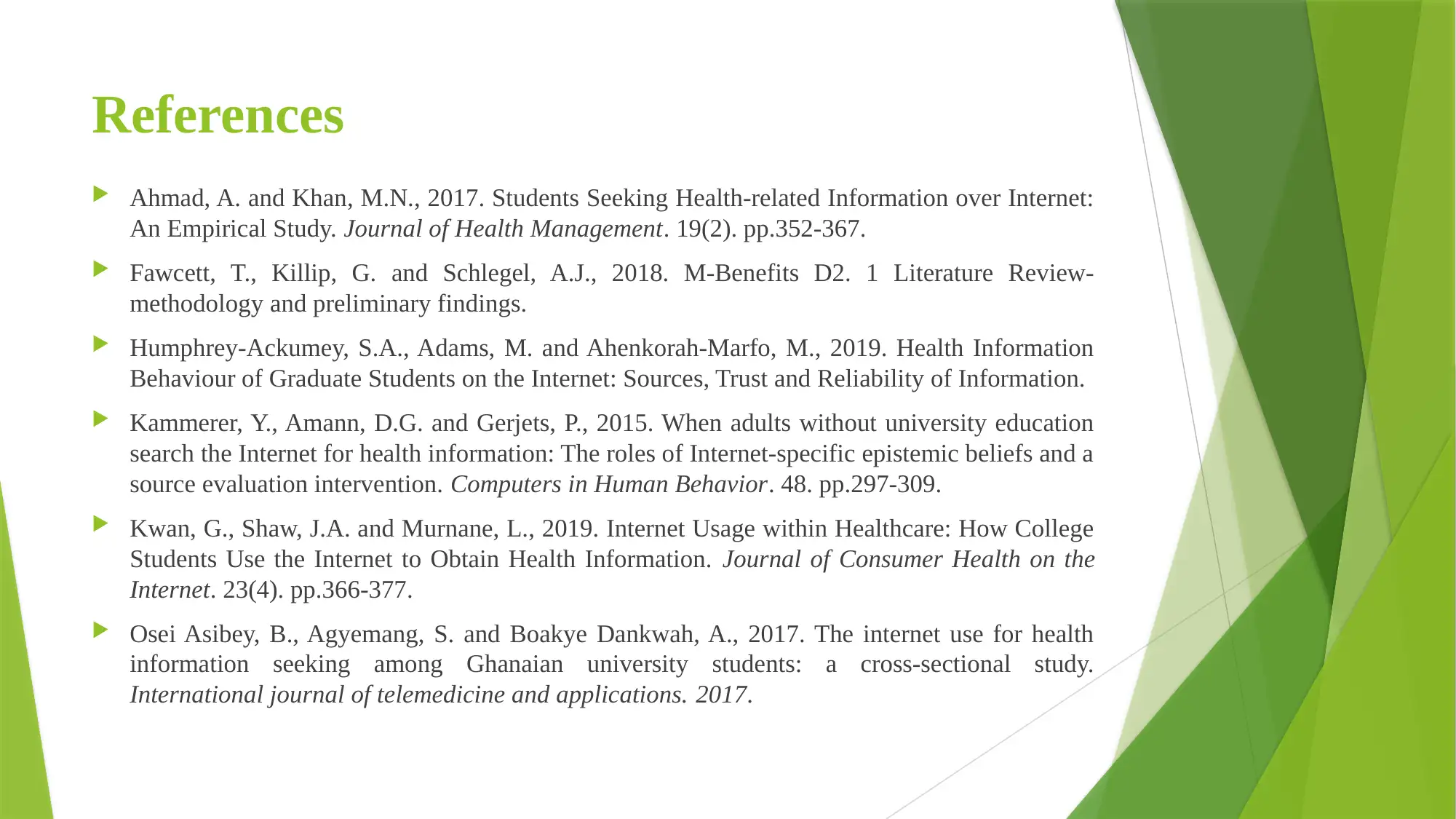
References
Ahmad, A. and Khan, M.N., 2017. Students Seeking Health-related Information over Internet:
An Empirical Study. Journal of Health Management. 19(2). pp.352-367.
Fawcett, T., Killip, G. and Schlegel, A.J., 2018. M-Benefits D2. 1 Literature Review-
methodology and preliminary findings.
Humphrey-Ackumey, S.A., Adams, M. and Ahenkorah-Marfo, M., 2019. Health Information
Behaviour of Graduate Students on the Internet: Sources, Trust and Reliability of Information.
Kammerer, Y., Amann, D.G. and Gerjets, P., 2015. When adults without university education
search the Internet for health information: The roles of Internet-specific epistemic beliefs and a
source evaluation intervention. Computers in Human Behavior. 48. pp.297-309.
Kwan, G., Shaw, J.A. and Murnane, L., 2019. Internet Usage within Healthcare: How College
Students Use the Internet to Obtain Health Information. Journal of Consumer Health on the
Internet. 23(4). pp.366-377.
Osei Asibey, B., Agyemang, S. and Boakye Dankwah, A., 2017. The internet use for health
information seeking among Ghanaian university students: a cross-sectional study.
International journal of telemedicine and applications. 2017.
Ahmad, A. and Khan, M.N., 2017. Students Seeking Health-related Information over Internet:
An Empirical Study. Journal of Health Management. 19(2). pp.352-367.
Fawcett, T., Killip, G. and Schlegel, A.J., 2018. M-Benefits D2. 1 Literature Review-
methodology and preliminary findings.
Humphrey-Ackumey, S.A., Adams, M. and Ahenkorah-Marfo, M., 2019. Health Information
Behaviour of Graduate Students on the Internet: Sources, Trust and Reliability of Information.
Kammerer, Y., Amann, D.G. and Gerjets, P., 2015. When adults without university education
search the Internet for health information: The roles of Internet-specific epistemic beliefs and a
source evaluation intervention. Computers in Human Behavior. 48. pp.297-309.
Kwan, G., Shaw, J.A. and Murnane, L., 2019. Internet Usage within Healthcare: How College
Students Use the Internet to Obtain Health Information. Journal of Consumer Health on the
Internet. 23(4). pp.366-377.
Osei Asibey, B., Agyemang, S. and Boakye Dankwah, A., 2017. The internet use for health
information seeking among Ghanaian university students: a cross-sectional study.
International journal of telemedicine and applications. 2017.
⊘ This is a preview!⊘
Do you want full access?
Subscribe today to unlock all pages.

Trusted by 1+ million students worldwide
1 out of 9